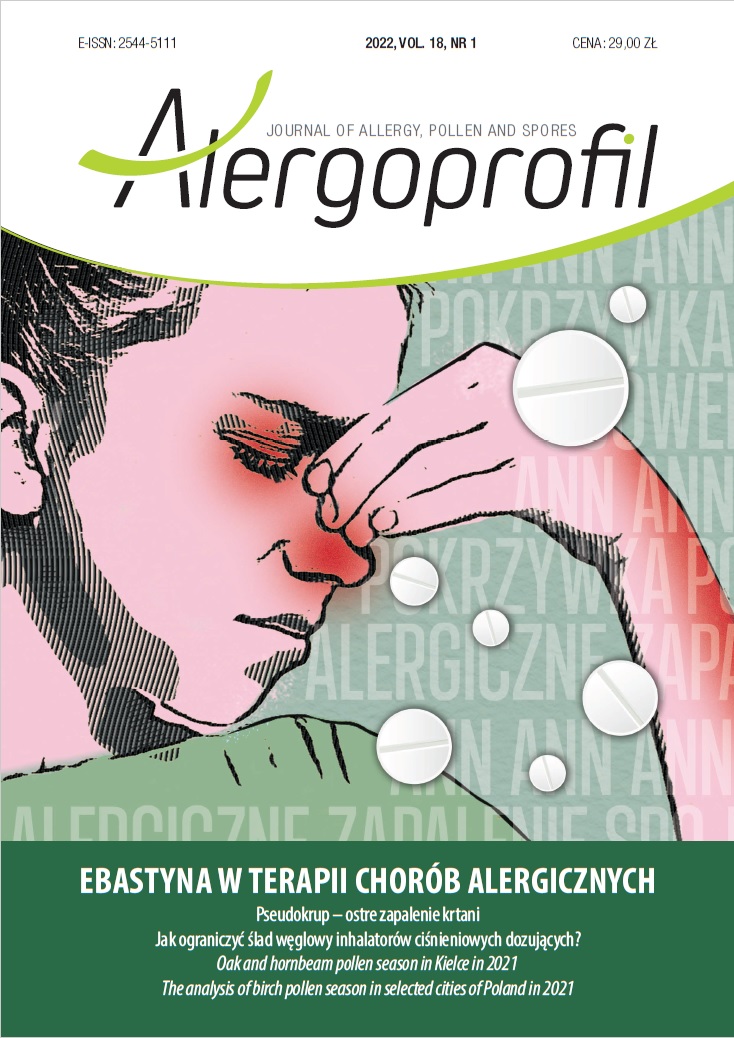Oak and hornbeam pollen season in Kielce in 2021 Original article
Main Article Content
Abstract
The paper presents the characteristics of oak and hornbeam pollen seasons in Kielce in 2021. Aeropalinological measurements were carried out with the use of the volumetric method. The main oak pollen season lasted 35 days. The maximum concentration of oak pollen, i.e. 227 grains in 1 m3 of air, was recorded on May 20, and the seasonal pollen index was estimated at 1533. The hornbeam pollen season was longer, i.e. 56 days. The peak hornbeam pollen release was recorded on April 28, when 22 pollen grains in 1 m3 of air were noted, with the annual concentration sum of 207. The study also determined the effect of some meteorological factors on the concentration of pollen grains of the analyzed plant taxa. The meteorological parameters were found to exert the strongest effect on the dynamics of the hornbeam pollen season.
Downloads
Article Details

This work is licensed under a Creative Commons Attribution-NonCommercial 4.0 International License.
Copyright: © Medical Education sp. z o.o. This is an Open Access article distributed under the terms of the Attribution-NonCommercial 4.0 International (CC BY-NC 4.0). License (https://creativecommons.org/licenses/by-nc/4.0/), allowing third parties to copy and redistribute the material in any medium or format and to remix, transform, and build upon the material, provided the original work is properly cited and states its license.
Address reprint requests to: Medical Education, Marcin Kuźma (marcin.kuzma@mededu.pl)
References
2. Rapiejko A, Malkiewicz M, Ziemianin M et al. Oak pollen concentratio n in the air of selected Polish cities in 2020. Alergoprofil. 2020; 16(4): 15-20. http://doi.org/10.24292/01.AP.1643311220.3.
3. Rapiejko P. Alergeny pyłku dębu. Alergoprofil. 2007; 3(3): 34-8.
4. Lipiec A, Puc M, Malkiewicz M et al. Analiza stężenia pyłku dębu w wybranych miastach Polski w 2015 r. Alergoprofil. 2015; 11(3): 45-9.
5. Dąbrowska-Zapart K, Chłopek K, Malkiewicz M et al. Oak pollen season in selected cities of Poland in 2019. Alergoprofil. 2019; 15(2): 12-6. http://doi.org/10.24292/01.AP.152150919 .
6. Szafer W, Kulczyński S, Pawłowski B. Rośliny Polskie. PWN, Warszawa 1988.
7. Puc M, Myszkowska D, Chłopek K et al. Oak pollen in the air of Poland in 2017. Alergoprofil. 2017; 13(3): 124-8. http://doi.org/10.24292/01.ap.300917.
8. Rapiejko P, Lipiec A, Jurkiewicz D. Alergogenne znaczenie pyłku dębu. Alergia. 2004; 2: 38-41.
9. Rapiejko P, Stankiewicz W, Szczygielski K et al. Progowe stężenie pyłku roślin niezbędne do wywołania objawów alergicznych. Otolar Pol. 2007; 61(4): 591-4.
10. Burge HA. Monitoring for airborne allergens. Ann. Allergy. 1992; 9: 9-21.
11. Puc M, Kotrych D, Piotrowska-Weryszko K et al. Hornbeam pollen in the air of Poland in 2018. Alergoprofil. 2018; 14(3): 72-6. http://doi.org/10.24292/01.AP.291918.
12. Chłopek K, Rapiejko P, Lipiec A et al. Analiza stężenia pyłku grabu (Carpinus) w wybranych miastach Polski w 2007 r. Alergoprofil. 2007; 3(3): 39-44.
13. Pidek IA. Carpinus betulus pollen accumulation rates in Roztocze (SE Poland) in relation to presence of Carpinus in Ferdynandovian pollen diagrams. Ecological Questions. 2017; 27: 95-101. http://doi.org/10.12775/EQ.2017.023.
14. Bachofer M, Mayer J. Drzewa. MULTICO Oficyna Wydawnicza, Warszawa 2007.
15. Pokorny J. Drzewa znane i mniej znane. Polska Oficyna Wydawnicza „BGW”, Warszawa 1992.
16. Seneta W, Dolatowski J. Dendrologia. PWN, Warszawa 2008.
17. Mattiesen F, Ipsen H, Lowenstein H. Pollen allergens. In: D’Amato G, Spieksma FTM, Bonini S (ed). Allergenic pollen and pollinosis In Europe. Blackwell Scientific Public, London 1991: 36-44. mined by cross-hybridization. J. Allergy Clin. Immunol. 1991, 87(3): 677-82.
18. Valenta R, Breiteneder H, Petternburger K et al. Homology of the major birch-pollen allergen, Bet v I, with the major pollen allergens of alder, hazel and hornbeam at the nucleic acid level as determined by cross-hybridization. J Allergy Clin Immunol. 1991; 87(3): 677-82.
19. Rapiejko P. Wybrane aspekty alergii krzyżowej. Alergoprofil. 2006; 2(2): 11-5.
20. Lipiec A, Puc M, Kalinowska E et al. Pyłek grabu w powietrzu wybranych miast Polski w 2014 r. Alergoprofil. 2014; 10(3): 48-53.
21. Gumowski PI, Clot B, Davet A et al. The importance of hornbeam (Carpinus sp.) pollen hypersensitivity in spring allergies. Aerobiologia. 2000; 16: 83-6.
22. Emberlin J, Savage M, Jones S. Annual variations in grass pollen seasons in London 1961-1990: trends and forecast models. Clin Exp Allergy. 1993; 23(11): 911-8.
23. Instytut Meteorologii i Gospodarki Wodnej – Państwowy Instytut Badawczy. (access: 27.07.2021).
24. Ślusarczyk J, Kopacz-Bednarska A, Posłowska J. Characteristics of ash, maple, yew/juniper, and willow pollen seasons in the air of Kielce in 2021 in correlation with weather conditions. Alergoprofil. 2021; 17(4): 3-10. http://doi.org/10.24292/01.AP.174181021.
25. Ianovici N, Bîrsan MV. The influence of meteorological factors on the dynamic of Ambrosia artemisiifolia pollen in an invaded area. Not Bot Horti Agrobo. 2020; 48(2): 752-69. http://doi.org/10.15835/nbha48211862.
26. Dąbrowska-Zapart K, Chłopek K, Niedźwiedź T. The impact of meteorological conditions on the concentration of alder pollen in Sosnowiec (Poland) in the years 1997–2017. Aerobiologia. 2018; 34: 469-85. http://doi.org/10.1007/s10453-018-9524-8.
27. Majeed HT, Periago C, Alarcón M et al. Airborne pollen parameters and their relationship with meteorological variables in NE Iberian Peninsula. Aerobiologia. 2018; 34: 375-88. http://doi.org/10.1007/s10453-018-9520-z.

